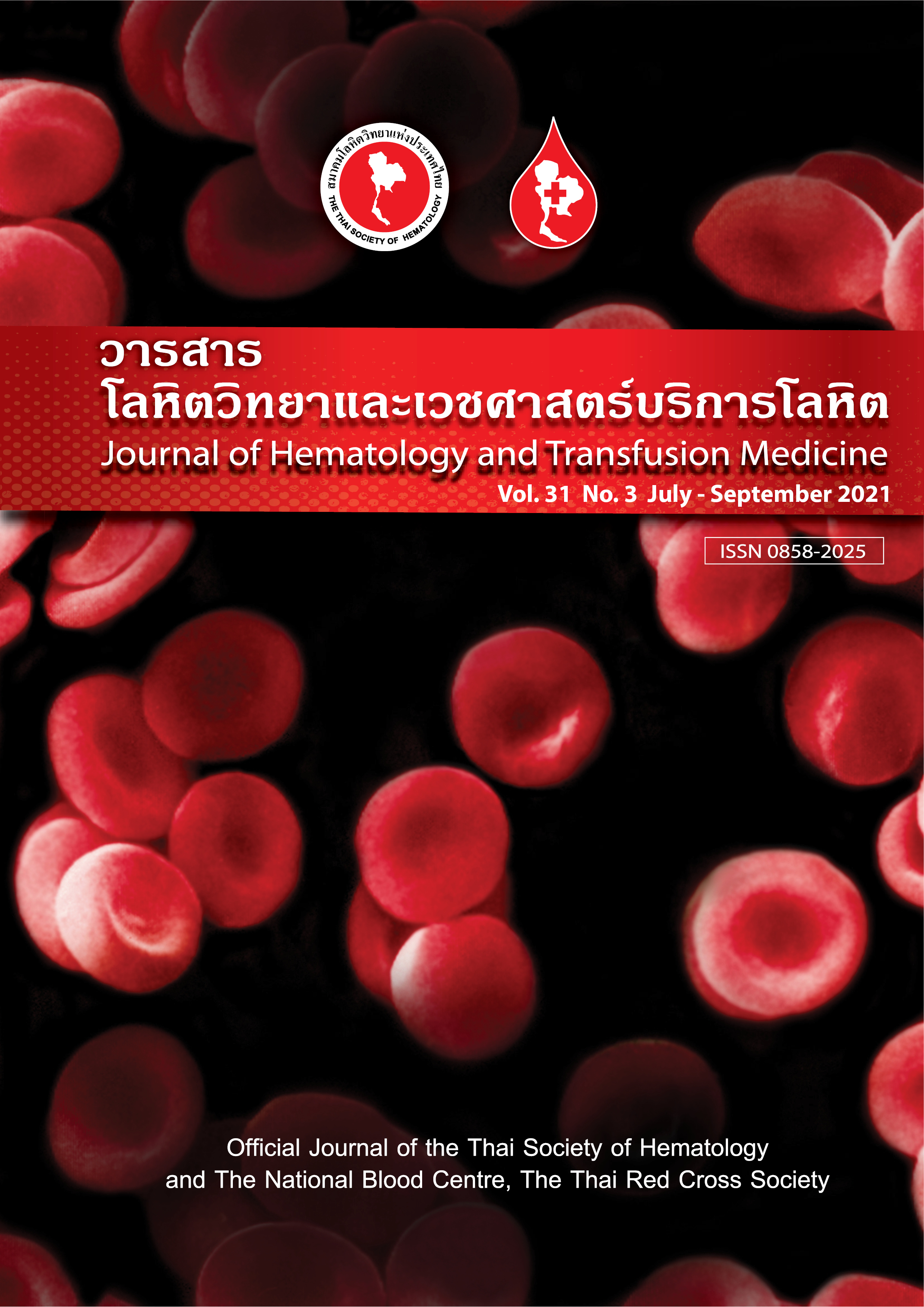Effect of turbid plasma and biochemical levels on ABO blood group testing by an image-based automated analyzer
Keywords:
Turbid plasma, Lipemia, Interference, ABO blood group testingAbstract
Abstract:
Introduction: Turbid plasma affects the analysis of several laboratory tests. Objectives: To investigate the possible effects of plasma turbidity and the biochemical levels on the ABO blood group testing by QWALYS®3, an automated device that interprets the results by image-based analysis. Materials and Methods: A total of 205 known ABO blood group samples composed of non-error (n=100), error “X” (n=50), and error “?” (n=55) results by QWALYS®3 were measured for biochemical levels and the turbidity of plasma, followed by their associations being tested. Then, the risk factors of the error results were calculated. To verify the risk factors of the biochemical levels, the plasma of blood group B with various concentrations of each biochemical substance was tested using QWALYS®3. Results: Plasma turbidity was positively correlated with the levels of globulin, total protein, and triglyceride. For ABO blood group testing by QWALYS®3, the turbid samples with OD > 1.000 were associated with errors “X” and “?”. In multivariate analysis, the concentration of total protein ≤ 8.0 g/dL and the triglyceride > 500 mg/dL were the independent risk factors for both errors. The risk factors verified that a 1,700 mg/dL of triglyceride had a direct effect on ABO blood group testing with error “?” and, a 3,400 mg/dL of triglyceride affected error “X”. Conclusion: The high triglyceride levels and total protein ≤ 8.0 g/dL could affect the ABO blood group testing using an image-based automated analyzer. Thus the rejection of specimens by turbidity assessment may reduce the error results of blood group testing, caused by high triglyceride levels.
บทคัดย่อ
บทนำ พลาสมาขุ่นส่งผลกระทบต่อการตรวจวิเคราะห์ทางห้องปฏิบัติการได้หลายการทดสอบ วัตถุประสงค์ เพื่อวิเคราะห์ผลของความขุ่นและระดับสารชีวเคมีในพลาสมาต่อการตรวจหมู่เลือด ABO ด้วยเครื่อง QWALYS®3 ซึ่งเป็นเครื่องอัตโนมัติที่มีการอ่านและแปลผลการตรวจจากภาพ วัสดุและวิธีการ นำตัวอย่างเลือด 205 ราย ที่มีผลตรวจหมู่เลือด ABO จากการตรวจด้วยเครื่อง QWALYS®3 ประกอบด้วย รายงานผลได้ 100 ราย รายงานผลไม่ได้ชนิด “X” 50 ราย และชนิด “?” 55 ราย นำมาตรวจระดับสารชีวเคมีและระดับความขุ่นของพลาสมา จากนั้นวิเคราะห์ความสัมพันธ์และปัจจัยเสี่ยงของตัวอย่างตรวจที่รายงานผลไม่ได้ รวมทั้งทวนสอบปัจจัยเสี่ยงของระดับสารชีวเคมีต่อผลการตรวจหมู่เลือดโดยใช้พลาสมาหมู่เลือด B ที่ถูกเติมสารชีวเคมีระดับต่าง ๆ แล้วนำมาทดสอบหมู่เลือด ABO ด้วยเครื่องอัตโนมัติ ผลการศึกษา ความขุ่นของพลาสมามีความสัมพันธ์เชิงบวกกับระดับโกลบูลิน โปรตีนรวม และไตรกลีเซอไรด์ การตรวจหมู่เลือด ABO ด้วยเครื่อง QWALYS®3 พบว่า ตัวอย่างขุ่นที่มีค่า OD > 1.000 มีความสัมพันธ์กับการรายงานผลไม่ได้ทั้งชนิด “X” และ “?” เมื่อวิเคราะห์หลายปัจจัยร่วมกัน พบว่า ความเข้มข้นของโปรตีนรวม ≤ 8.0 g/dL และไตรกลีเซอไรด์ > 500 mg/dL เป็นปัจจัยเสี่ยงอิสระต่อการรายงานผลไม่ได้ทั้งสองชนิด การทวนสอบปัจจัยเสี่ยงพบว่า ค่าไตรกลีเซอไรด์ 1,700 mg/dL และ 3,400 mg/dL มีผลต่อการตรวจหมู่เลือด ABO โดยทำให้อ่านผลไม่ได้ชนิด “?” และ “X” ตามลำดับ สรุป ไตรกลีเซอไรด์ระดับสูงและโปรตีน ≤ 8.0 g/dL มีผลต่อการตรวจหมู่เลือด ABO ด้วยการใช้เครื่องอัตโนมัติที่อาศัยการอ่านผลด้วยภาพซึ่งสนับสนุน การปฏิเสธสิ่งส่งตรวจจากการประเมินความขุ่นเพื่อลดการรายงานผลไม่ได้ของการตรวจหมู่เลือดด้วยเครื่องวิเคราะห์อัตโนมัติได้
Downloads
References
Nikolac N. Lipemia: causes, interference mechanisms, detection and management. Biochem Med (Zagreb). 2014;24:57-67.
Calmarza P, Cordero J. Lipemia interferences in routine clinical biochemical tests. Biochem Med (Zagreb). 2011;21:160-6.
Agarwal S, Vargas G, Nordstrom C, Tam E, Buffone GJ, Devaraj S. Effect of interference from hemolysis, icterus and lipemia on routine pediatric clinical chemistry assays. Clin Chim Acta. 2015;438:241-5.
Negrini D, Bernardi D, Antonelli G, Plebani M. Interference of lipemia in samples for routine coagulation testing using a Sysmex CS-5100 coagulometer. Int J Lab Hematol. 2019;41:772-7.
Walker PL, Crook MA. Lipaemia: causes, consequences and solutions. Clin Chim Acta. 2013;418:30-2.
Mainali S, Davis SR, Krasowski MD. Frequency and causes of lipemia interference of clinical chemistry laboratory tests. Pract Lab Med. 2017;8:1-9.
Franchini M, Liumbruno GM, Lippi G. The prognostic value of ABO blood group in cancer patients. Blood Transfus. 2016;14:434-40.
Huang JY, Wang R, Gao YT, Yuan JM. ABO blood type and the risk of cancer - Findings from the Shanghai Cohort Study. PLoS One. 2017;12:e0184295. doi: 10.1371/journal.pone.0184295.
Song Q, Wu JZ, Wang S, Chen ZB. The ABO blood group is an independent prognostic factor in patients with ovarian cancer. J Cancer. 2019;10:6754-60.
Tanaka Y, Kumagi T, Terao T, Kuroda T, Yokota T, Azemoto N, et al. ABO blood type and the long-term outcomes of pancreatic cancer. Intern Med. 2020;59:761-8.
Osada Y, Ito C, Nishiyama-Fujita Y, Ogura S, Sakurai A, Akimoto M, et al. Prognostic impact of ABO blood group on survival in patients with malignant lymphoma. Clin Lymphoma Myeloma Leuk. 2020;20:122-9.
Parente EB, Harjutsalo V, Lehto M, Forsblom C, Sandholm N, Groop PH, et al. Relationship between ABO blood groups and cardiovascular disease in type 1 diabetes according to diabetic nephropathy status. Cardiovasc Diabetol. 2020;19:68.
Zhong GC, Liu S, Wu YL, Xia M, Zhu JX, Hao FB, et al. ABO blood group and risk of newly diagnosed nonalcoholic fatty liver disease: A case-control study in Han Chinese population. PLoS One. 2019;14:e0225792. doi: 10.1371/journal.pone.0225792.
Malvik N, Leon J, Schlueter AJ, Wu C, Knudson CM. ABO-incompatible platelets are associated with increased transfusion reaction rates. Transfusion. 2020;60:285-93.
Behtaj M, Zhu ML, Bittencourt CE, Ha JP, Maitta RW. Non-O blood group thrombotic thrombocytopenic purpura patients take longer to recover as measured by number of therapeutic plasma exchanges needed for platelet recovery. Thromb Res. 2020;185:78-84.
Roback JD, Grossman BJ, Harris T, Hillyer CD. Red cell typing. In: Technical Manual. 17th ed. Bethesda, MD: American Association of Blood Banks; 2011. p. 876-7.
Morelati F, Revelli N, Maffei LM, Poretti M, Santoro C, Parravicini A, et al. Evaluation of a new automated instrument for pretransfusion testing. Transfusion. 1998;38:959-65.
SandLer SG, Langeberg A, Avery N, Mintz PD. A fully automated blood typing system for hospital transfusion services. ABS2000 Study Group. Transfusion. 2000;40:201-7.
Bouix O, Ferrera V, Delamaire M, Redersdorff JC, Roubinet F. Erythrocyte-magnetized technology: an original and innovative method for blood group serology. Transfusion. 2008;48:1878-85.
Mistry H, Poles D, Watt A, Bolton-Maggs PHB, SHOT Steering Group. Human errors in manual techniques for ABO/D grouping are associated with potentially lethal outcomes. Transfus Med. 2019;29:262-7.
Adiga U, Malawadi BN. Lipemic index – a tool to measure lipemia. Int J Med Res Rev. 2016;4:613-7.
Marshall WL, Bangert SK, Lapsley M. Lipids, lipoproteins and cardiovascular disease. In: Marshall WL, Bangert SK, Lapsley M, editors. Clinical chemistry. 7th ed. London: Mosby Elsevier; 2012. p. 239-58.
Kaewduang P, Wongsena W, Sranujit R, Kuaha K. Risk factors for lipemic plasma in blood donors. J Hematol Transfus Med. 2017;27:117-25.
Peffer K, de Kort WL, Slot E, Doggen CJ. Turbid plasma donations in whole blood donors: fat chance? Transfusion. 2011;51:1179-87.
Munnix ICA, Raijmakers MTM, Oosterhuis WP, Kleinveld HA. Detection of a monoclonal gammopathy by lipemia-index measurement. Ned Tijdschr Klin Chem Labgeneesk. 2009;34:248-9.
Armstrong B. Antigen-antibody reactions. VOXS. 2008;3:21-32.



